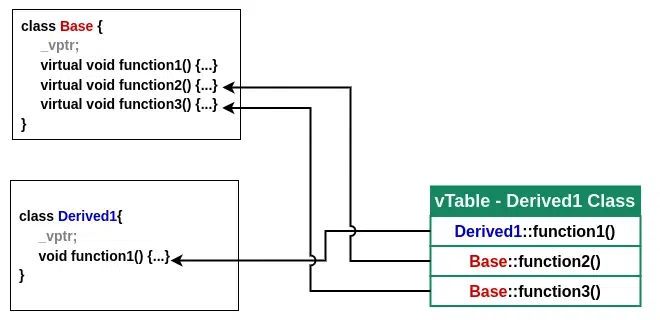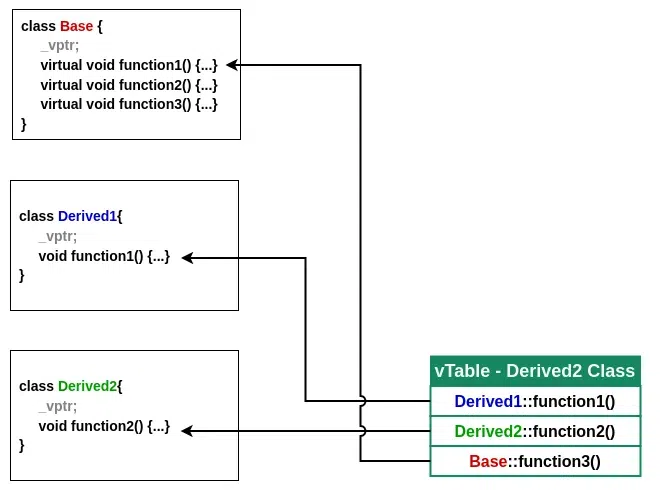vTable And vPtr in C++
Last Updated :
25 Nov, 2023
In C++, runtime polymorphism is realized using virtual functions. But have you ever wondered how virtual functions work behind the scenes? The C++ language uses Vtable and Vptr to manage virtual functions. In this article, we will understand the concepts of Vtable and Vptr in C++.
Prerequisites: C++ Polymorphism, Inheritance in C++.
What is Polymorphism?
In OOPs, polymorphism refers to the ability of objects to have names but different functionality. The most common use is with base class pointers or references calling derived class functions. This is called runtime polymorphism and is implemented in C++ using virtual functions.
Virtual Functions in C++
A virtual function is a member function that is declared within a base class with the virtual keyword and is re-defined (Overridden) by a derived class. When a class contains a virtual function, it can be overridden in its derived class and tells the compiler to perform dynamic linkage (or late binding) on the function. Now, the virtual functions are implemented in C++ by using vTable and vPtr.
What is vTable?
The vTable, or Virtual Table, is a table of function pointers that is created by the compiler to support dynamic polymorphism. Whenever a class contains a virtual function, the compiler creates a Vtable for that class. Each object of the class is then provided with a hidden pointer to this table, known as Vptr.
The Vtable has one entry for each virtual function accessible by the class. These entries are pointers to the most derived function that the current object should call.
What is vPtr (Virtual Pointer)?
The virtual pointer or _vptr is a hidden pointer that is added by the compiler as a member of the class to point to the VTable of that class. For every object of a class containing virtual functions, a vptr is added to point to the vTable of that class. It’s important to note that vptr is created only if a class has or inherits a virtual function.
Understanding vTable and vPtr Using an Example
Here is a simple example with a base class Base and classes Derived1 derived from Base and Derived2 from class Derived1.
C++
#include <iostream>
using namespace std;
class Base {
public:
virtual void function1()
{
cout << "Base function1()" << endl;
}
virtual void function2()
{
cout << "Base function2()" << endl;
}
virtual void function3()
{
cout << "Base function3()" << endl;
}
};
class Derived1 : public Base {
public:
void function1()
{
cout << "Derived1 function1()" << endl;
}
};
class Derived2 : public Derived1 {
public:
void function2()
{
cout << "Derived2 function2()" << endl;
}
};
int main()
{
Base* ptr1 = new Base();
Base* ptr2 = new Derived1();
Base* ptr3 = new Derived2();
ptr1->function1();
ptr1->function2();
ptr1->function3();
ptr2->function1();
ptr2->function2();
ptr2->function3();
ptr3->function1();
ptr3->function2();
ptr3->function3();
delete ptr1;
delete ptr2;
delete ptr3;
return 0;
}
|
Output
Base function1()
Base function2()
Base function3()
Derived1 function1()
Base function2()
Base function3()
Derived1 function1()
Derived2 function2()
Base function3()
Explanation
1. For Base Class
The base class have 3 virtual function function1(), function2() and function3(). So the vTable of the base class would have 3 elements i.e. function pointer to base::function()

Base Class vTable
2. For Derived1 Class
The Derived1 class inherits 3 virtual functions from the Base class but overrides only function1() so all the other functions will be the same as the base class.

Derived1 Class vTable
3. For Derived2 Class
The Derived2 class is inherited from Derived1 class so it inherits the function1() of Derived1 and function2() and function3() of Base class. In this class, we have overridden only function2(). So, the vTable for Derived2 class will look like this

Derived2 Class vTable
Share your thoughts in the comments
Please Login to comment...